This is the fourth in a series of case studies that use a new methodology to assess the deconstruction potential of new build properties. The case studies and methodology have been funded by the BRE Trust to raise awareness amongst architects, designers and contractors of the potential of Design for Deconstruction (DfD) to create more sustainable buildings and lead to better deconstruction outcomes.
Introduction
This an unusual type of building within the UK which accommodates an 8,000m2 air tight box indoor skiing area with a 160m main slope and a 100m nursery slope. There is also an amenities building which incorporates a three-storey ‘warm side’ area with shops, restaurants and equipment hire facilities. It was built from 2008 to 2009.
Building description
A concrete floor slab was used with a steel frame and concrete retaining walls. To avoid any danger of heave caused by freezing on the slope below the floor slab, heating pipes were embedded in a light layer of concrete to maintain a constant temperature in the surrounding ground. A key requirement was to provide good levels of thermal insulation in a tough environment, similar to a cold store requirements.
The roof is a gentle, straight pitched roof (rather than domed) and the amenities building has a mono-pitch roof of the same both with a ‘nature roof’ design. The key construction challenge was working on the
sloping ski floor, which starts 32m above the building’s ground floor level at a pitch of 15 degrees. This will also have implications during deconstruction. The total floor space of the building is approximately 10,500m2. The building’s specification is summarised in Table 1.
| Construction | Description |
| Frame | Main ski block – Steel portal frame; Amenity block – Concrete frame up to first floor steel frame above |
| Foundation | Concrete pad foundation |
| Ground floor | In-situ concrete slab, 75mm thick extruded polystyrene foam boards fixed in two layers deep on the ski slopes |
| Upper floor | In-situ concrete floor on metal deck Timber decking on metal joists |
| External walls | Rain screen cladding (timber, flat/profiled sheets), Structurally insulated 150mm backing panels, screwed on to concrete frame, Aluminium curtain wall glazing |
| Internal walls | Metal stud partition walls, plaster board, paint |
| Roof | Green roof, aluminium insulated composite panel on metal roof structure |
| Windows | Powder coated aluminium windows, double glazed Aluminium window sill |
| Floor finishes | Rubber flooring, vinyl flooring and carpet tiles |
| Cladding | Siberian larch with one coat of solvent Aluminium profile and flat panel composite cladding |
| Sanitary ware | Ceramic dual flush WC; sink with low flow taps; wet room with ceramic tiling |
| Services | Air handling units |
| Fixtures and Fittings | Fitted chipboard kitchen units including cabinets Steel staircase and balustrading Aluminium flashing |
Table 1: Building specification
Project documentation
As a standardised industrial building construction, a step by step sequence was followed during construction, and the same principles would have to be applied for deconstruction. Risk assessment records, produced as part of CDM regulation, hold the information for maintenance as well as dismantling the structure.
There was no clear brief or commitment within the project brief to design for deconstruction. Therefore no active allocation of responsibility for ensuring designing for deconstruction was made within the project team.
Hand over documentation includes “As built” construction details but not the sequence of erecting different elements. The contractor has a visual recording of construction and installation of each components and sub-components; however, this was not handed over to the client.
Connections
Overall score 69%
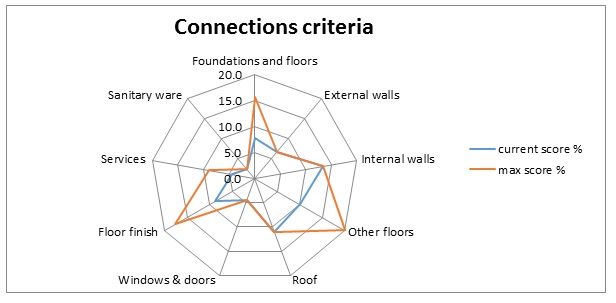
All of the structural steel framework across the building were delivered in sections and bolted together on site; enabling them to be unbolted for reuse. The timber cladding was nailed to timber battens, which were bolted on to structural steel frame. The flat panel metal rain screen cladding was riveted to the base frame. The mechanical fixings will aid in undertaking deconstruction.
The structural steel frames are bolted into the concrete pillars or the foundations; in some places it is set within the concrete retaining walls. The geometry of the components edges in relation to the connection design will dictate whether or not the components can be disassembled. A lightweight 100mm green roof on rubber drainage matting is simply laid on top of the metal deck roofing, allowing for easy removal (Figure 1).
Accessibility
Overall score 57%
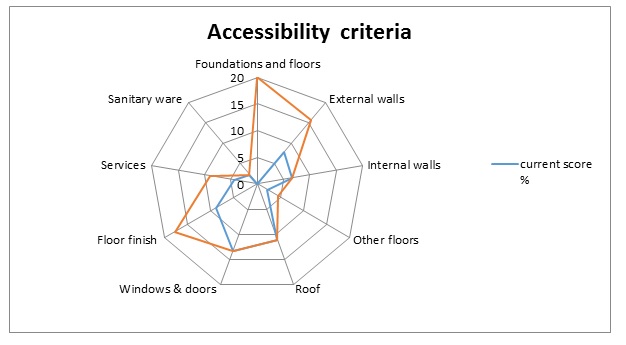
An external roof walkway is in place to give full accessibility for maintenance. As seen in Figure 2, all high level lights are accessible from the central service corridor at roof level. Access to the external wall cladding and gutter cleaning can be carried out using scissor lifts. All internal finishes in the amenity block can be soft stripped as and when a refit is required ort at end of life.
Reuse and recycling potential
Overall score 58%
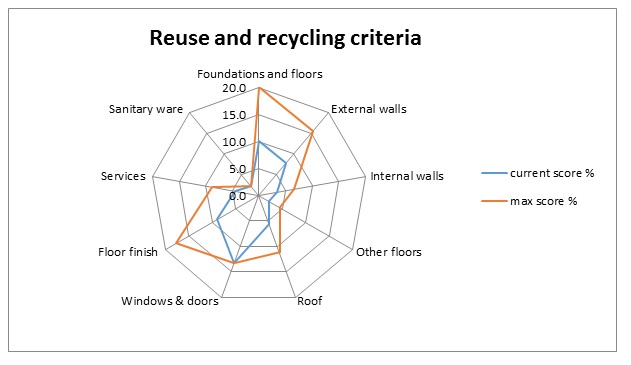
Primary material types used in the building are concrete, steel, metal stud, glass and cladding of timber and aluminium. The steel frames could be reused, for a project of a similar construction requirement. The cladding could also be reused.
The mineral wool, extruded polystyrene insulation, the insulated panel backing and the composite metal roof are difficult to currently recycle. The rubber and vinyl flooring are unsuitable for reuse. Vinyl flooring can be recycled. The carpet tiles can be reused.
The majority of materials including timber cladding, aluminium components and structural steel can be easily retrieved during maintenance/demolition for reuse.
The concrete floor and foundation, could be recycled as aggregate, depending on whether it is possible to separate and sort steel and concrete cost-effectively.
Optimisation of deconstruction
Overall score 66%
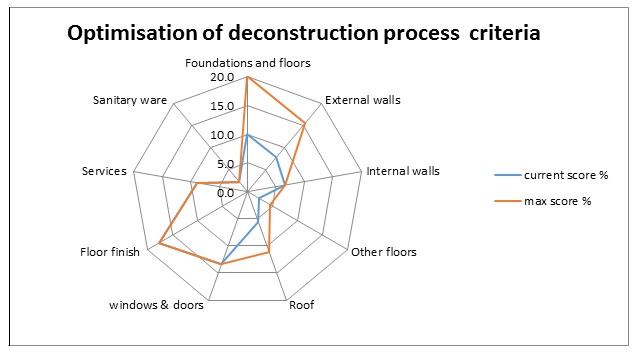
The concrete ski floor should be removed first to give access for scaffolding in order to remove any internal service, fixtures and fittings. Where structural steel frames are cast into retaining walls, it would have to be cut-off at the base in order to recycle or re-use. Cladding panels are all screwed, except the flat panel rain screen cladding which is riveted, and can be dismantled using a standard removal process.
Fixture and fittings
The building services i.e. air handling units and condensers were pre-mounted on to steel decking modules (6×7.5m) and bolted together on-site. Individual plant could be lowered down in the same way as it was installed. Internal finishes (e.g. carpet tiles, doors and windows) can be removed easily. The main staircase is constructed from steel sections with steel balustrades, which can be unbolted and reused.
Summary
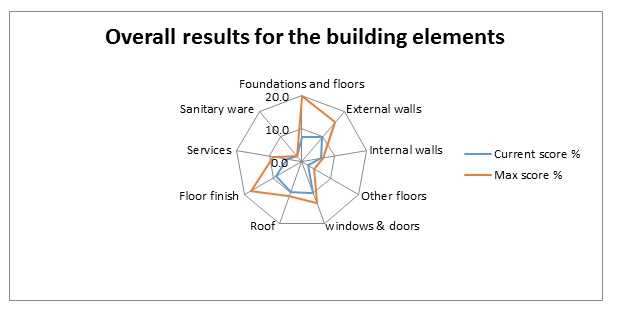
The ski slope case study scored 61% overall for its DfD potential. Figure 3 shows the overall score by element. Elements which had greater potential for DfD are the steel frames, the cladding, the services and a number of the internal finishes. The connections criteria (69%) and the optimisation of the deconstruction process (66%) scored the highest and access the lowest (57%). A large number of mechanical fixings have been used which will aid the deconstruction process, as well as having accessibility a key requirement for operation maintenance. Key issues summarised are:
- Steel frames lend themselves for reuse. They are usually tested for their strength properties and coatings will be removed; they can then be refabricated which may involve cutting to new lengths. For this case study, the frame will have to be cut where it is set in the concrete retaining wall.
- Due to the use of rivets, bolts and nails for the cladding, it should be relatively easy to demount these for reuse.
- Whilst the green roof could be reused as it is simply laid onto the metal decking roof, it is currently unknown if this a viable option, as it is a relatively new construction type, with little cases of it reaching end of life.
- A number of materials are difficult to recycle, currently including the mineral wool, extruded polystyrene insulation, the insulated panel backing, composite metal roof and rubber flooring. More consideration can be given to products which are easier to recycle at end of life.
- The building services can be deconstructed following the same way they were constructed; however these details may be missing when the building reaches its end of life.
